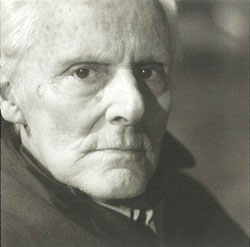Mário Cesariny
Mário Cesariny Lisboa ¶ 1923-2005 ¶ Lisboa
 |
|
| Créditos fotográficos / Photographic credits: Susana Paiva/ Cortesia Assírio & Alvim |
He was a poet and a painter. His education was diverse: he went through the António Arroio Decorative Arts School course, he studied music with composer Fernando Lopes Graça and attended the Parisian academy La Grande Chaumière. ¶ He is considered the single most important poet of the Portuguese Surrealist movement, being a major influence for the foundation of the Surrealist Group of Lisbon in 1947, the exact same year when he met André Breton in person, which of course would make a mark in his own pictorial and literary career. His restless personality and natural ideological divergences would lead him away from the first group, and form a new one, The Surrealists. On that occasion he wrote the Manifesto Abjeccionista (The Abjectness Manifesto) with fellow writer Pedro Dom. ¶ Cesariny wrote poetry and ever-polemic interventions, put up quite important anthologies, whether of Portuguese or world-class Surrealism, and did translations of Rimbaud, Buñuel and Novalis. ¶ As for his painting, it was in the very early 40s that he first began painting (as well as writing poems and making drawings). After a brief stroll-like passage through neo-realism and the influences of Portuguese poets Cesário Verde and the Futurist Álvaro de Campos, it is in fact in the surrealist school that he finds his own style. However, Cesariny's painting was never a quote-convergent exercise, or an out-performance of the themes, forms and landscapes that make up the usual, hackneyed image of what Surrealism stands for. ¶ In the case of Cesariny's painting, it's impossible to come up with a unified, general theory. As with his poetry, his painting is both spontaneous and subversive, with small whiffs of a magic, dreamlike dimension, with a strong presence of colour, of disorder or even the chaos that is usually associated with the surrealist automatisms and chance methods. The non-sensical and the absurd, so typical a stock-in-trade of the first Avantgardes, are also present in Cesariny's painting, but they're also to be found in his objects and "assemblages". His was a continuously aesthetic experimental approach, whether through the use of less conventional means such as collage and water painting, or through other means. Nonetheless, they all amount to a very coherent visual oeuvre. ¶ As a major advocate and promoter of the surrealist movement in Portugal, it comes as no surprise that Mário Cesariny came to exert powerful influence over several Portuguese artists. The 2002 Grand Prix EDP for the Visual Arts recognized his special contribution to the Portuguese Arts of the 20th century.
View the embedded image gallery online at:
http://cvc.instituto-camoes.pt/biografias-en/mario-cesariny-64610.html#sigFreeIdf85f47023d
http://cvc.instituto-camoes.pt/biografias-en/mario-cesariny-64610.html#sigFreeIdf85f47023d


